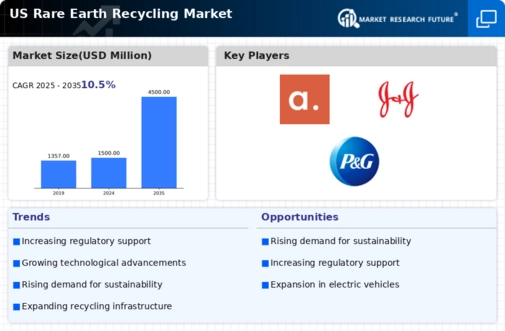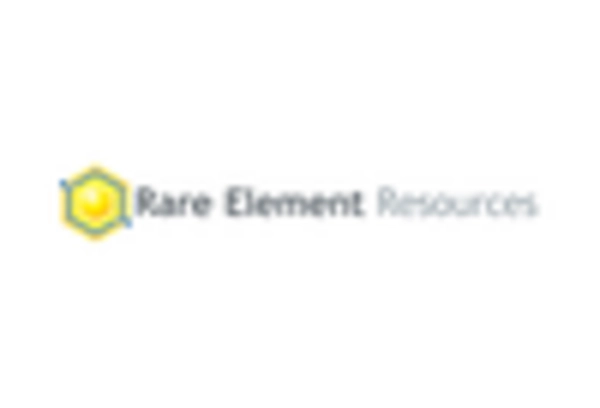Increasing Resource Scarcity
The rare earth-recycling market is experiencing a notable surge due to the increasing scarcity of natural resources. As the demand for rare earth elements (REEs) escalates, the supply from traditional mining sources becomes more constrained. This scarcity drives industries to seek alternative sources, such as recycling, to meet their needs. In the US, the reliance on imported REEs has raised concerns about supply chain vulnerabilities, prompting a shift towards recycling initiatives. The market is projected to grow as companies recognize the potential of recycling to provide a sustainable and reliable source of these critical materials. The rare earth-recycling market is thus positioned to benefit from this trend, as it offers a solution to mitigate resource scarcity while promoting environmental sustainability.
Government Incentives and Funding
Government incentives and funding initiatives are playing a crucial role in shaping the rare earth-recycling market. The US government has recognized the strategic importance of rare earth elements for national security and technological advancement. As a result, various programs and grants are being introduced to support recycling initiatives. For instance, funding for research projects aimed at improving recycling technologies and infrastructure is becoming more prevalent. This financial backing encourages private sector participation and innovation within the rare earth-recycling market. The potential for increased funding could lead to a more competitive landscape, fostering growth and development in the recycling sector.
Strategic Partnerships and Collaborations
Strategic partnerships and collaborations among stakeholders are emerging as a key driver in the rare earth-recycling market. Companies are increasingly recognizing the value of working together to enhance recycling capabilities and share resources. Collaborations between technology firms, recycling companies, and manufacturers can lead to the development of innovative solutions that improve the efficiency of rare earth recovery. In the US, such partnerships are likely to facilitate knowledge transfer and accelerate the adoption of advanced recycling technologies. The rare earth-recycling market stands to gain from these collaborative efforts, as they can enhance operational efficiencies and expand market reach.
Technological Innovations in Recycling Processes
Technological advancements in recycling processes are significantly influencing the rare earth-recycling market. Innovations such as hydrometallurgical and pyrometallurgical methods enhance the efficiency of extracting rare earth elements from electronic waste and other sources. These technologies not only improve recovery rates but also reduce the environmental impact associated with traditional mining. The US market is witnessing increased investment in research and development to refine these processes, which could lead to a more robust recycling infrastructure. As a result, the rare earth-recycling market is likely to expand, driven by the need for efficient and sustainable recycling solutions that align with the growing demand for REEs in various applications.
Rising Consumer Awareness and Demand for Circular Economy
The growing consumer awareness regarding environmental issues is driving the rare earth-recycling market towards a circular economy model. As consumers become more conscious of the environmental impact of electronic waste, there is a rising demand for products that incorporate recycled materials. This shift in consumer behavior is prompting manufacturers to adopt sustainable practices, including the use of recycled rare earth elements in their products. The rare earth-recycling market is thus likely to benefit from this trend, as companies strive to meet consumer expectations for sustainability. The integration of recycled materials not only enhances brand reputation but also aligns with regulatory pressures for reduced waste and increased recycling.

















Leave a Comment